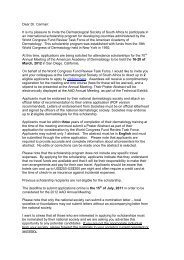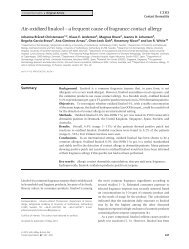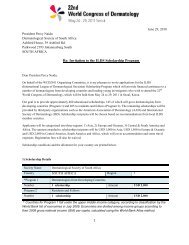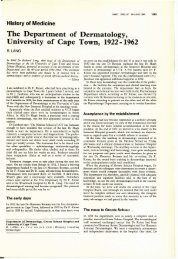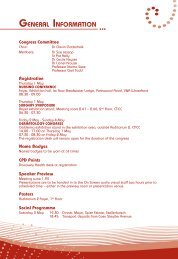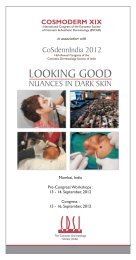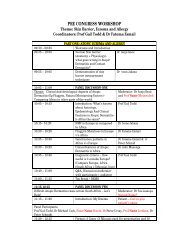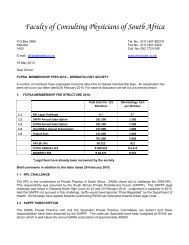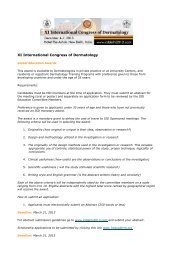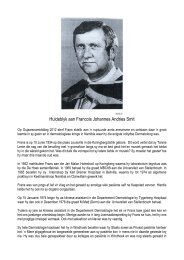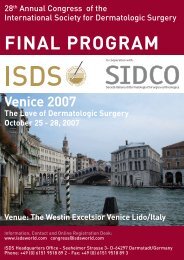Guidelines on the Management of Atopic Dermatitis ... - Dermatology
Guidelines on the Management of Atopic Dermatitis ... - Dermatology
Guidelines on the Management of Atopic Dermatitis ... - Dermatology
You also want an ePaper? Increase the reach of your titles
YUMPU automatically turns print PDFs into web optimized ePapers that Google loves.
7. George S, Bilsand D, Johns<strong>on</strong> BE et al. Narrow-band UVB (TL-01) airc<strong>on</strong>diti<strong>on</strong>ed <strong>the</strong>rapy for<br />
chr<strong>on</strong>ic severe adult atopic eczema. Acta Derm Venereol Suppl (Stockh) 1992;176:137-8<br />
Systemic <strong>the</strong>rapy in atopic dermatitis<br />
Narrowband UVB, methotrexate and ciclosporin remain reas<strong>on</strong>able first-line systemic<br />
treatments for atopic dermatitis, with mycophenylate and azathioprine as sec<strong>on</strong>d line<br />
opti<strong>on</strong>s. 1<br />
Ciclosporin [1+; A]<br />
<strong>Atopic</strong> dermatitis symptoms resp<strong>on</strong>d to ciclosporin because <strong>the</strong> disease is mediated by<br />
activated T cells and thus is sensitive to a reducti<strong>on</strong> in IL-2 expressi<strong>on</strong>. The role <strong>of</strong><br />
ciclosporin in severe, refractory atopic dermatitis is well established.<br />
C<strong>on</strong>sistent evidence was found that short-term use <strong>of</strong> <strong>the</strong> drug effectively decreased atopic<br />
dermatitis severity. 2<br />
In patients in whom atopic dermatitis cannot be c<strong>on</strong>trolled by standard topical <strong>the</strong>rapies,<br />
ciclosporin significantly decreases symptom scores, disease extent, pruritus and sleep<br />
deprivati<strong>on</strong>, and has also been shown to improve QOL. Ciclosporin is used as an additi<strong>on</strong>al<br />
<strong>the</strong>rapy. Topical <strong>the</strong>rapies should not be disc<strong>on</strong>tinued while systemic treatment is<br />
administered.<br />
Exclusi<strong>on</strong> criteria for <strong>the</strong> use <strong>of</strong> <strong>the</strong> drug are: Renal or liver impairment, hypertensi<strong>on</strong>,<br />
previous or current malignancies, epilepsy primary or sec<strong>on</strong>dary immunodeficiency. 3<br />
Drugs to avoid while treating with Ciclosporin: 2<br />
Erythromycin, Clarithromycin, itrac<strong>on</strong>azole and n<strong>on</strong>-steroidal anti-inflammatory drugs.<br />
Dosages, side-effects and m<strong>on</strong>itoring<br />
The recommended starting dosage, in children is 5mg/kg daily in divided dosages for <strong>the</strong><br />
first two weeks, by which time a clinical improvement should be observed. The dosage can<br />
<strong>the</strong>n be reduced to 1.5-3 mg/kg/day, according to clinical resp<strong>on</strong>se and <strong>the</strong> patient‟s serum<br />
creatinine levels. If a clinical resp<strong>on</strong>se is observed, <strong>the</strong> ciclosporin dose can be tapered<br />
slowly over <strong>the</strong> next 2-3 m<strong>on</strong>ths. The total length <strong>of</strong> treatment is usually 6-12 m<strong>on</strong>ths.<br />
The most comm<strong>on</strong> adverse effects may include hypertensi<strong>on</strong>, renal dysfuncti<strong>on</strong>, headache,<br />
hypertrichosis, gingival hyperplasia and paraes<strong>the</strong>sia. Renal toxicity, which is dose and time<br />
related, can be acute or chr<strong>on</strong>ic, but usually resp<strong>on</strong>ds rapidly to ei<strong>the</strong>r reducti<strong>on</strong> in dose or<br />
cessati<strong>on</strong> <strong>of</strong> <strong>the</strong> drug.<br />
Paediatric trials indicate that renal toxicity and hypertensi<strong>on</strong> are rare in children.<br />
Azathioprine [1+; A]<br />
It has several adverse effects, including myelosuppressi<strong>on</strong>, hepatotoxicity and susceptibility<br />
for infecti<strong>on</strong>, and <strong>the</strong> recommended dosage (1-3mg/kg/day) should be determined <strong>on</strong> <strong>the</strong><br />
basis <strong>of</strong> individual thiopurinemethyltransferase (TPMT) levels. 4



